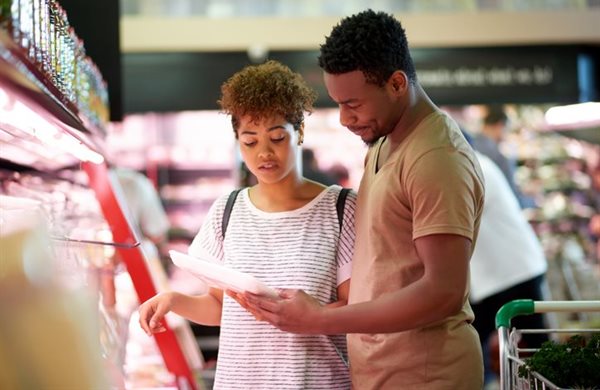Online shopping saw exponential growth rates in 2020, owing to the Covid-19 pandemic and the associated lockdown regulations.

Getty
The largest online shopping category in South Africa is fashion, which accounted for 31% of total e-commerce revenue, while food and personal care (grocery retailers) only accounted for 8%. This can be attributed to the challenges in e-grocery retailing, such as the low availability of online stock, skepticism about the freshness of produce, changing customer expectations, logistical and delivery problems, and technological issues such as not updating the site, difficulty navigating the site, and payment methods.
In addition, the majority of South African consumers are low-income earners who have limited access to the internet owing to high data costs, a poor telecommunications infrastructure in certain areas, and a lack of digital literacy, all of which prevents their buying groceries online. There is thus still a large proportion of the South African consumer market that prefers to shop at physical grocery stores.
Thus the question arises: What can grocery retailers do to ensure that they retain their current customers and attract more customers to their stores once the Covid-19 pandemic has ended?
1. Interaction and engagement
Stephan le Roux, retail director at Growthpoint Properties, emphasises that physical stores are about engagement with and interaction between people – that is, shoppers and retailers.
To ensure the survival of physical grocery stores, grocery retailers need to enhance and improve their engagement with consumers through their employees. Many consumers feel more comfortable and reassured when interacting with employees in person.
2. Convenience
A study by Google sub-Saharan Africa that was conducted to obtain insights into South African retailers discovered that convenience is one of the most popular drivers of purchasing at physical stores. Consumers are moving away from shopping malls, preferring to shop at smaller shopping centres for convenience.
Another major consumer behavioural trend is the shift from monthly shopping to weekly and daily shopping, which has resulted in increased traffic to shopping centres for convenience and away from shopping malls. Therefore grocery retailers should develop smaller stores and place them in shopping centres instead.
3. Health protocols
Physical grocery retailers are currently implementing health protocols such as providing sanitising stations, monitoring the number of consumers in the store, requiring them to wear masks, and using perspex screens at cash tills.
These health protocols should be advertised through in-store signage, sending SMSes and emails to consumers, and posting on social media to draw consumers to the physical store.
4. In-store technologies
In line with the health protocols mentioned above, physical grocery retailers should also implement contactless in-store technologies. These include self-service checkouts, grocery vending machines, artificial intelligence voice and gesture recognition software, and integrating smartphones and mobile applications such as QR code scanners or creating systems like Amazon Go.
These in-store technologies aim to limit physical contact, ensuring that consumers are more comfortable about visiting a physical store. Through promotions and advertising, grocery retailers could attract consumers to their physical stores.
5. Delivery technologies
For consumers who use public transport and who struggle to carry many grocery bags, or for consumers who live in rural or remote locations, grocery retailers could implement new delivery technologies such as drones and robots.
Shoppers could purchase their desired products from the physical grocery stores, and retailers could offer an option to deliver these products to their homes. The use of drones and robots could overcome the challenges faced by lower-income earners who live in rural or township locations, yet still draw them to the physical store to purchase.
6. Flagship stores
Flagship stores are lead stores in a retail chain that aims to attract customers to the retail brand rather than making sales by acting as a showcase for the retailer. Flagship stores have recently become quite popular, and are a way to increase foot traffic.
Checkers opened its flagship store in Sandton City Mall in 2019, and more recently Food Lover’s Market introduced its flagship store in Midrand.
Flagship stores help to increase awareness, create an experience for customers, use innovative approaches, and develop customer retention. Physical grocery store retailers should therefore consider placing flagship stores in shopping centres to attract customers to their physical outlets.
7. Promotions
Physical grocery retailer stores can advertise and promote exclusive store promotions to drive traffic to the store. These could include in-store discounts, coupons, and competitions. Grocery retailers could advertise extensively using traditional media such as radio advertisements, pamphlets in newspapers, outdoor advertising in taxi ranks and bus stops, as well as digital media such as SMSes and social media.
8. Innovative business models
Grocery retailers need to revise their business models and become aware that a one-size-fits-all strategy is no longer helpful. The ideas of an online channel and a physical store should no longer be looked at in isolation, but rather be seen as an integrated approach to retailing once the Covid-19 pandemic is has ended.
Many retailers have recently invested heavily in online outlets, but have forgotten about the traditional consumer. Grocery retailers should therefore create innovative business models such as agile store formats, omnichannel strategies, and customer-centric strategies.
Despite the growth and popularity of online shopping, if South African retail grocery stores are to remain successful, they will need to consider the socio-economic issues that the majority of South African consumers face. These pose significant challenges and negatively impact consumers’ ability to shop online.
Grocery retailers not only want to retain their current customers, but also attract more customers to their stores once the Covid-19 pandemic has ended. In essence, the survival of physical grocery stores post-Covid-19 is possible, provided that these retailers implement new and innovative solutions.
































